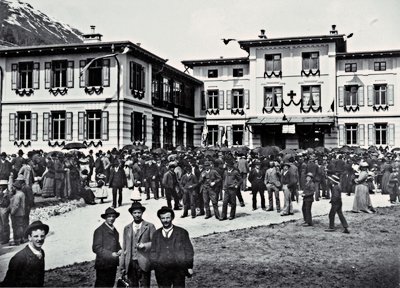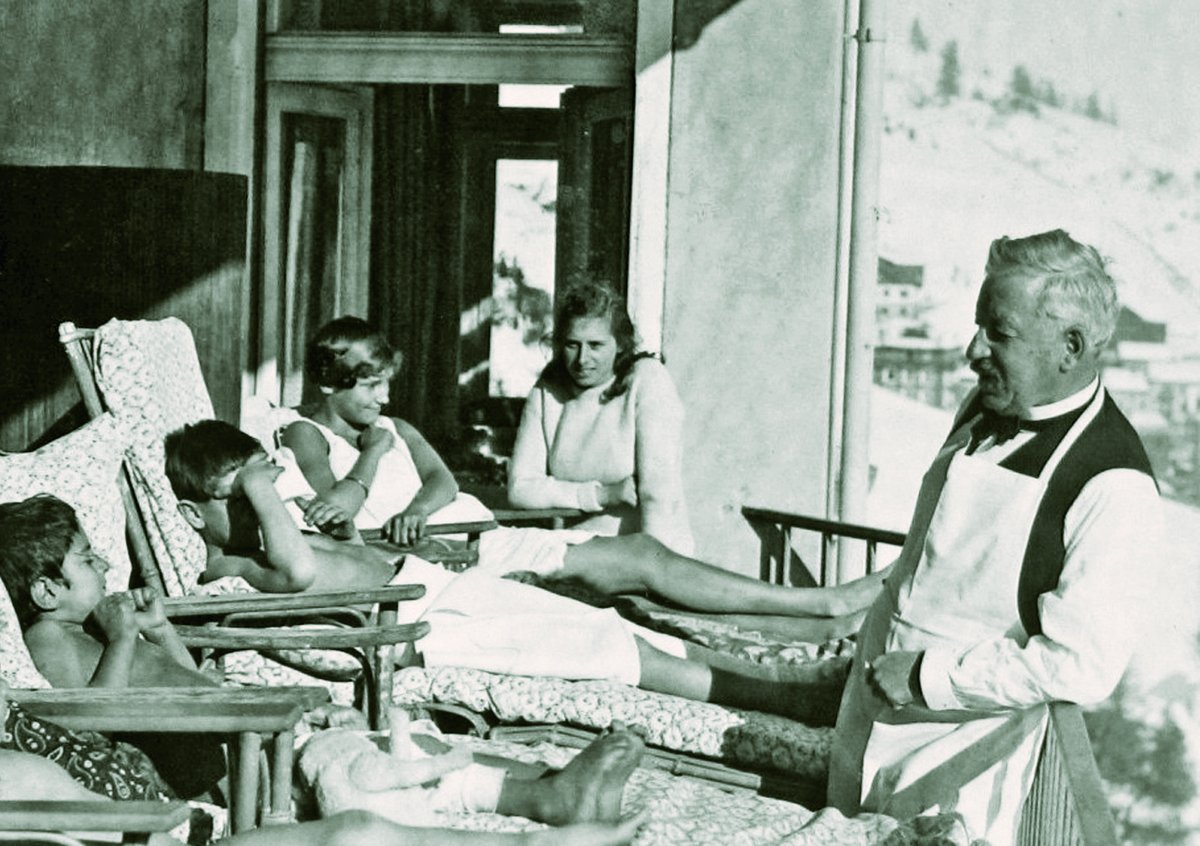How a brain wave conquered the world!
High altitude medicine and heliotherapy in the Samedner Hospital
by Heini Hofmann
The highest acute hospital in Europe is in the town of Samedan, in the South West Swiss canton of Grisons, near San Moritz. Well-deserved birthday celebrations just this year had spoiled this joy through an exceptional epidemiological situation. Let us however take a look in the rear-view mirror at the remarkable history of this hospital, founded 125 years ago in 1895.
At the beginning of the second half of the 19th century, the mountainous canton of Grisons, with its 150 valleys, had only two small hospitals located in the cantonal capital Chur. The railway ended at Chur necessitating a gruelling further 12 hour journey by horse across the Julier Pass from the Engadine. Medicine in the Alpine valleys was as yet rudimentary, and infectious diseases were treated in infirmaries such as the Ospidel Vegl in Samedan. Indeed the title “Ospidel” was probably a euphemistic one for what was in point of fact only a “hospice for the dying”. It offered no treatment.
Father pharmacist –
son medical doctor
At that time a mere handful of physicians cared for the population of the Upper Engadine. Prominent among them was Oscar Bernhard, son of the pharmacist Samuel Bernhard, who became famous for his “medicinal” bitter-aromatic herbal liqueur “Iva”. It remains the national drink of the Engadine. It is made from the “mountain yarrow” flower. His Iva factory opened in 1880 in Samedan and was one of the village’s first small industrial enterprises. Vis-à-vis the Academia Engiadina, where once the Kurhaus Spa was located, the yellow building still stands today.
Young Bernhard was a product of his mountain culture. At 16 he had shot his first chamois and by 18 had obtained his mountain guide’s licence. He studied medicine in Zurich, Heidelberg and Bern and went on to assist the Bernese Nobel Prize-winning surgeon Theodor Kocher. Upon completion of his studies and his placement in the medical officer school he opened a medical practice in Samedan with a branch clinic in the mountaineering village of Pontresina. Soon ‘Il Bernard’, as the population of the Engadine and the southern valleys titled him, became respected both as a doctor and a surgeon.
Pioneer of mountain rescue
At that time, a medical practice located in the mountains was no walk in the park. It meant visiting sick people by day and by night, in all weathers, even snowstorms, sometimes on foot or on horseback. In emergencies Il Bernard often had to operate in the patients’ own homes, in low-ceiling Engadine rooms or on a kitchen table, by the light of a petrol-fuelled lamp. His practice of operating on the elderly initially aroused some suspicion. According to an older colleague a policy of not letting the elderly die in peace was “a cheeky disturbance of the worldorder”…
At this time, the quest to explore and to climb mountains tended to displace due respect for the Alpine terrain. This led to mountaineering accidents. As rescue services were still in their infancy, Oscar (Il) Bernhard, as a practical doctor, high mountain hunter, mountain guide and president of the Bernina section of the Swiss Alpine Club, took the initiative. His famous information panels with practical mountain rescue instructions became a bestselling almanac, as well as a working tool for the Samaritan services, the Alpine Club and the army.
Highest acute hospital
It evokes little wonder that, together with others of his ilk, this man of action was responsible for the Engadin’s acquiring a hospital. On 12 May 1895, initially with just 35 beds, the Samedan District Hospital, opened 1750 metres (5740 feet) above sea level. Aged only 34, Il Bernard became its first ‘conducting’ doctor (today: ‘chief physician’) and remained in office until 1907. After just one year of operation, those in charge declared: “It is mainly thanks to him that the hospital has achieved its already high reputation in its first year of existence.”
A confirmatory note resounded in the No. 19 issue of the “Allgemeines Fremdenblatt, St. Moritz” 19 August 1896: “The Upper Engadine District Hospital seems to be becoming a more and more international place of refuge for sick people. The fact that recently the inmates belonged to five different language areas bears witness to this development. There was a Roman, an Italian, a German, a Frenchman and an Englishman together in one room.”
The daily hospital charge was then for the 3rd class Sfr. 1.50 - 2.50 and for the 1st class Sfr. 10 to 20.
A flash of sunny insight
In February 1902 a decisive event occurred thanks to a flash of inspiration and a brand new therapy was created in this small Samedner hospital. It was a therapy which went on to become a worldwide success. This is how it happened: The surgical wounds of an Italian were not healing despite best efforts. He had suffered severe knife wounds. During a morning visit, the sun was shining through the open windows, warming the patient and “a tingling air” filled the hospital room. Il Bernard had a decisive flash of inspiration. Analogously with the local practice of preserving the Bündner Bindenfleisch speciality by drying (see box), might not the tanning of sunlight and fresh air work also on a living patient’s tissue? Perhaps such exposure would dry, granulate and thus heal the wound? He moved the bed up to the open window and exposed the wound. After only one and a half hours, improvement became apparent and after repeated tanning, the wound was completely covered with skin and had healed.
Cradle of heliotherapy
This great success prompted Bernhard to treat all infected wounds from then on with solar radiation; later also fistulas, tuberculous ulcers and even bone tuberculosis. He hypothesised that the sun also had a depth effect. He used all available tools: chemicals, light, heat and pain killing medicines, even though the latter had side effects. The heliotherapy of surgical tuberculosis (joint and bone tuberculosis, in contrast to pulmonary tuberculosis) had been “invented” and went on a worldwide triumphal march. The Samedner Hospital can be proud of this fact! Samedan itself could have become famous thanks to this globally acclaimed medical discovery – if it had been assessed correctly at the time. Unfortunately the success of one so capable was neither appreciated nor recognised and ended with a note of bitterness. As a “thank you” for his services, he was bullied out of Samedan Hospital. The exchange of letters in connection with his resignation “to the titular District Office of the Upper Engadin, pro Hospital Commission” is voluminous and ends with the statement: “The fact that I had to experience such ingratitude troubles me and many right-minded people with me.”
Out of the frying pan into the fire
For the sake of objectivity it must be added that the question as to who was ultimately responsible for the severance remains unanswered. But one fact remains: Samedan had lost its son, one who was to become famous later.
Even this tragedy was not enough. Even in St. Moritz, to which he now removed himself, he was not well-well-received – at first. Here, people feared for the good reputation of the world famous tourist destination. At the time people did not know how to distinguish between the highly infectious pulmonary tuberculosis and the only slightly or entirely non-infectious joint and bone tuberculosis.
In St. Moritz, he first built and operated a villa with an integrated mini-hospital on a beautiful hillside location. Because heliotherapy had become a booming success he soon was overrun with international patients. His Sun Clinic was built above Villa Bernhard as early as 1911/12. It became the first Engadine Belle Epoque Hospital, enjoying a worldwide reputation. Next he wanted to build a monumentally dimensioned solar clinic directly above his clinic; but St. Moritz vetoed the project. This perhaps is the explanation of how a possible Nobel Prize candidate for medicine became grounded in his own country.
Prophet in his own fatherland
Thus, the founder of heliotherapy had had his hands tied at home, while in Leysin and in other countries, his ‘sun clinics’ sprouted like mushrooms. It was only in foreign fields that his expertise in the construction of sun clinics remained in demand. For example he was requested by the Grand Duchess Luise of Baden, who had come to know him at the Samedan hospital, to construct a clinic in the Black Forest. The plaudits and international honours bestowed upon him were immense. But in his own homeland he has fallen into oblivion, especially since tuberculostatics have now made heliotherapy superfluous.
Although the sun doctor could have confined himself to working during the First World War in the safe haven of St. Moritz, his altruism drove him to contribute his medical knowledge and surgical skills where they were urgently needed – on the war front. He joined the Swiss mission as a military doctor.
On 14 November 1939, the sun doctor and founder of heliotherapy from Samedan died in a shady hospital room in St. Moritz. In the end he had been granted honorary citizenship of the town… •
Mountain disease in focus
hh. Another research focus at the Samedner Hospital deals with questions of high-altitude medicine, which – in recent times – have been addressed by Donald Marugg, the long-time head physician of the Medical Clinic, regarding Acute Mountain Sickness (AMS) including High-Altitude Cerebral Edema (HACE) and High-Altitude Pulmonary Edema (HAPE). A fact that proud masculinity is probably reluctant to acknowledge: Statistically speaking, women are less likely to be affected. Any more questions about the stronger sex?
Bündnerfleisch* and Birchermüesli
hh. Sometimes ground-breaking discoveries are based on coincidences (example: penicillin) or on very everyday things. This is the case with heliotherapy, which has helped hundreds of thousands of patients worldwide. In 1902, the Engadine Alpine physician Oscar Bernhard (1861–1939) came up with the idea of sun treatment through a eureka experience in the Samedan District Hospital, when he remembered how farmers in Graubünden used sun aids to dry meat. This principle now proved its worth in the treatment of wounds, fistulas and bone tuberculosis. Bündnerfleisch wrote medical history! Incidentally, meat with a bandage was not the only foodstuff that influenced the ‘invention’ of a doctor: at the same time, traditional cereal muesli dishes from the Alpine herdsmen gave the doctor and nutritionist Maximilian Bircher-Benner (1867–1939) the idea for his ‘Spys’, which later conquered the world as ‘Birchermüseli’ and is still on everyone’s lips today.
* Bündnerfleisch, also known as Bindenfleisch or Viande des Grisons, is an air-dried meat that is produced in the canton of Grisons, Switzerland.

